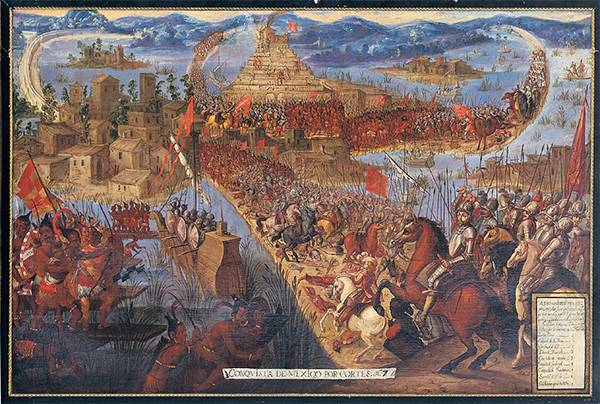Spain in the New World
Part 3: Aztecs and Inca
Cortés named the area New Spain and Mexico City its capital. King Charles I appointed Corés Governor of New Spain. Under his leadership, the city grew in influence and power, its representatives fanning out across Mesoamerica to establish relations with neighboring city-states. He proved far-thinking in one regard, setting up the encomienda system, a remnant of the feudal system in which Spanish nobles got the right to a certain number of native people who would provide labor as a means of maintaining the conqueror-conquered relationship. The conquered, in this case, also had to tribute, or taxes; and since money was in short supply, that tribute took several forms, among them animal food, various crops, and even raw metals. In return, the encomendero, or leader, would guarantee protection against attack. The Spanish Crown encouraged such enterprises, insisting that that protection also take the form of learning the Spanish language and the Christian faith. Spanish leaders brought the Inquisition to Mexico and kept it there for centuries. It was nowhere near as intensive or as deadly as it was in Spain, however. Farther south, a different set of explorers had set their sights on a different set of priorities. The goal was riches, as always, but exploration was also top of mind for Spaniards like Vasco Núñez de Balboa, the first known European to see the Pacific Ocean. Balboa had spent time on Hispaniola and had explored areas in what is now Colombia and Panama. It was in 1513 that he set out from the land of Veragua, of which he was governor, on an expedition to verify stories of a great body of water nearby and of a rich kingdom to the south. He and about 200 men marched south, fighting their way through what is now the Isthmus of Panama, and, on September 25, saw what is now the Pacific Ocean. Balboa called it the South Sea. He waded into it and claimed all of it and its shores for Spain. Balboa became entrenched in a power struggle that he eventually lost, when he was captured and tried for insurrection. The officer who arrested him was Franciso Pizarro. He and others first encountered the Inca Empire in the early 1520s. Fueled by stories of great riches to be had at the Inca capital, Cuzco, the Spaniards vowed to return. Along about the same time, a Portuguese captain sailing under the Spanish flag set out for a voyage around the world. Ferdinand Magellan didn't live to see his voyage's completion, having gone ashore to fight for control of the island of Mactan and lost his life. However, his lieutenant Juan Sebastián Elcano, who was from Spain, was the commanding officer of the Victoria, the one of five ships that did return, in September 1522. It was the first voyage to circle the globe, proving that the world was round. It was the first voyage to sail around the American continent and beyond. It was the first voyage to sail the width of Balboa's "South Sea." Pizarro returned to Spain and pleaded with King Charles I to finance another expedition. The king agreed and gave Pizarro the right to claim governorship of whatever lands he took. Returning to the New World, Pizarro brought with him his four brothers: Francisco, Gonzalo, Hernando, and Juan. The brothers Pizarro met up with Almagro, and the Spaniards made their way back to Inca lands. They returned in 1532. By that time, the Inca Empire had been wracked by disease and civil war. Explorers and conquistadores had reached the heart of the Inca realm. As these invaders did with the Aztecs, they brought with them a handful of diseases that proved lethal to the Inca, who had no immunity to such things. Smallpox killed thousands of Inca, including the emperor Huayna himself, in 1525. Pizarro took advantage of the civil war that had engulfed the Inca realm and ended up imprisoning and then executing the new emperor, Atahualpa, in 1533. That was effectively the end of the Inca Empire, although resistance continued sporadically for a handful of decades more. Spanish troops captured the last Inca ruler, Tupac Amaru, in 1572. The last resistance crumbled, the last remaining Inca surrendered and the Spanish conquest was complete. In 1542 came the Viceroyalty of Peru, set up to administer the conquest and conversion of western South America. |
|
Social Studies for Kids
copyright 2002–2026
David White



 Cortés returned in May 1521. This time, he was aiming at conquest. On Aug. 13, 1521, Cuauhtemoc surrendered and the Spanish victory was complete. To cement his dominance, Cortés ordered another round of mass executions and then ordered Tenochtitlan burned to the ground. On its ashes he ordered built Mexico City. Any Aztecs who survived fled to nearby Tlatelolco. The Spanish rule began.
Cortés returned in May 1521. This time, he was aiming at conquest. On Aug. 13, 1521, Cuauhtemoc surrendered and the Spanish victory was complete. To cement his dominance, Cortés ordered another round of mass executions and then ordered Tenochtitlan burned to the ground. On its ashes he ordered built Mexico City. Any Aztecs who survived fled to nearby Tlatelolco. The Spanish rule began.
